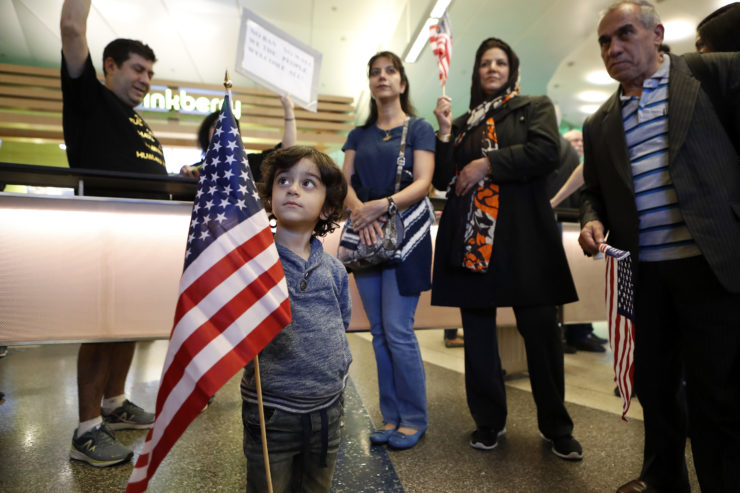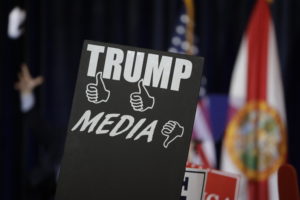
Three-year-old Shayan Ara holds an American flag as protests against President Donald Trump's executive order banning travel from seven Muslim-majority countries continue at Los Angeles International Airport on January 29, 2017
The story that has dominated coverage of Muslims in America this past year, especially these past few months, has been the rise of Islamophobia and how President Trump’s anti-Muslim rhetoric is affecting the American Muslim community. (This is followed closely by articles on hijab and Muslim women’s dress, the story that just will not die.) Now, the dominant story is President Trump’s executive order barring refugees and others from seven predominantly Muslim countries.
However, when you are a Muslim who manages coverage of Muslims in America, the responsibility of properly covering this story grows exponentially.
I’ve been covering this beat as a reporter and editor for 15 years. It’s taken me that long to develop the knowledge, know-how, intuitiveness and connections to properly cover this changing beat. Being a Muslim has helped immensely in building trusting relationships with sources and leaders. Even now, though, as managing editor of the Muslim Channel at Patheos, a multi-faith news and blog site, I’m still learning and growing as the community shifts and changes.
Because of my Muslim background, I am privy to perspectives that seem too often missed by mainstream religion reporters. Why, for example, do we discuss Islamophobia and the American Muslim community as a monolith? There are sub-communities within Islam that grapple with this issue in vastly different ways, from Black Muslims dealing with the implications of racial profiling and religious profiling to immigrant communities who may not understand their rights well enough. In fact, the term shouldn’t be American Muslim community but rather American Muslim communities.
Is Islamophobia really the story we should be covering? There are other social and civil justice issues Muslims are working on, such as the Black Lives Matter movement. Reporters should be facilitating relationships with Black Muslim organizations invested in this movement, like the Muslim Anti-Racism Collaborative (MuslimARC) or Sapelo Square.
And what about the pushback against the #MuslimBan from the Trump administration? Islamophobia may be the catalyst, as many Muslims are saying, for the #MuslimBan, but reporters may want to explore further the impetus for this executive order.
Surely it goes beyond fulfilling a campaign promise. Why were the seven countries in question—Yemen, Iraq, Iran, Somalia, Sudan, Libya, and Syria—chosen when there have been no fatal terrorist attacks carried out by a refugee or immigrant from these countries? (A few legal American citizens from these countries have engaged in violence.) Why aren’t Pakistan, Egypt, or Saudi Arabia part of President Trump’s list of banned countries?
Reporters may want to delve into the fact that the United States has had active bombing campaigns in five out of the seven banned countries. And, when the administration pushes back against those calling this a #MuslimBan, what about the president’s statement that he would give priority to Christian refugees?
Beyond these larger policy and political stories, what are the human stories that are missing? At Patheos, my writers are delving into personal stories of Sudanese Muslims affected by the ban: loved ones being kept apart, adults who are kept away from their parents’ funerals. We are working on stories of heartbreaking circumstances, like a mother of an autistic son who is visiting her sick father in Egypt. She holds a Yemeni passport and a green card, and while green card holders are supposed to be exempt from the ban, that has not always been the case.
I’ve seen these stories in mainstream outlets, like TIME, The Washington Post, and others, but I’ve also seen the call-out for these stories in my journalism circles: If you are an immigrant or refugee affected by the ban, please email XXX. The deeper, more meaningful stories come from building months of relationships beforehand, so that when a tense situation like this happens, the stories flood into your lap with urgency and detail.
What about the recent spate of stories of some American Muslims who claim they experienced Islamophobia or were targets of hate crimes, but it turns out they made the stories up? How do others in the American Muslim communities view this? What are the internal conversations that are happening here? If reporters would talk to Muslim educators, psychologists, or Muslim Student Association (MSA) advisors, you may hear theories about millennial Muslims who may be thinking of being the target of hate or Islamophobia to be a rite of passage and attention, or youth who may be facing problems with family and friends and would rather cry Islamophobia to explain their actions than admit to standard youthful rebellious acts. It’s never just about “crying wolf,” as I have learned from several internal community conversations.
So, how can mainstream journalists dig deeper and find different ways into stories about American Muslim communities?
It starts as any beat reporting starts—getting to know the main players in the community and talking to those already covering this beat. Ask American Muslim activists, leaders, scholars, imams, writers, artists, community organizers, and agitators what stories they want to see covered. Whose voices are still being marginalized? Who have we not heard from, and why should we be hearing from them?
Check out what Muslim journalists at non-mainstream publications—Patheos Muslim, MuslimMatters.org, Mvslim, The Islamic Monthly, MuslimGirl.com—are covering. For example, Hind Makki over at Patheos Muslim just published this piece about how Sudanese-Americans, a community often left out of news articles, are being affected by the ban. Mvslim offered this unique perspective of a Muslim reflecting on Holocaust Remembrance Day in light of Trump’s executive order, which was issued that very same day.
Last year CNN religion editor Daniel Burke called me just to talk and get to know each other. He sought my opinion about who in the American Muslim communities he should be talking to, what stories are not effectively being covered, what stories I was covering. Then, on November 9, he called me again to gauge my reaction to Trump’s surprising victory. I hesitated, not sure if I wanted to become part of the story. But that morning I felt blindsided as an American Muslim, not as an editor. And so, we talked. And an important story was heard.
The day after the election—after nearly a year of coordinating coverage of the 2016 campaign, after reporting on the rise of Islamophobia and targeted attacks against Muslims, after publishing stories on fear, racism, misogyny, and internal conflicts in American Muslim communities, after maintaining as much balance as possible in the coverage of Muslims in America during this tumultuous year—it felt personal, as if every vote for Donald J. Trump was a vote and an attack against me.
That feeling still lingers and lurks inside of me, though I know the best way to combat the internal sickening feeling is to simply do my job better—and try to help other editors, reporters and news agencies do their jobs better, too.



